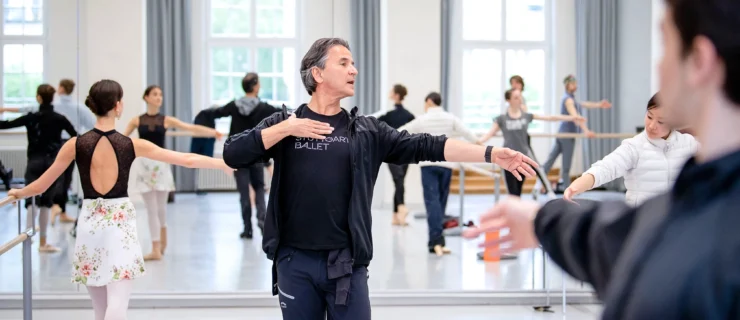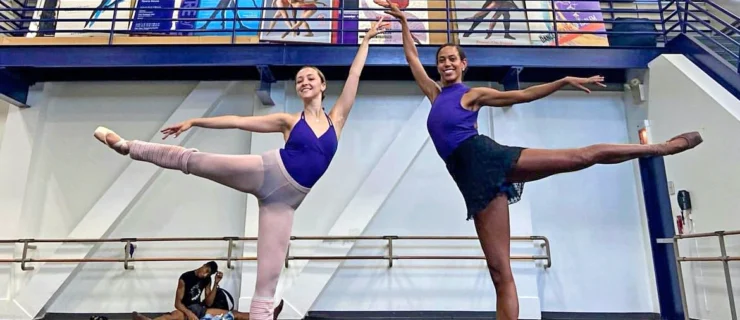New Horizons
When Yuki Komazaki, 28, and Nobuyoshi Okada, 29, decided they were ready to leave Orlando Ballet and seek out a new company, they started their search online. Visiting the websites of companies that intrigued them, they researched repertoires, touring schedules and—the couple’s most important consideration—teaching staff.
Doing that legwork, they agree, helped make for a comfortable transition to Louisville Ballet, where they’re in their first season as members of the corps de ballet. “We really wanted to spend the second half of our careers studying ballet from a different angle,” Okada says. “We had a lot of Cuban teachers in Orlando, which was great, but we wanted to learn from European teachers. That was what interested us the most. And when we came here we thought, ‘This is it. This is what we want.’”
The reasons dancers move from one company to the next are as individual as the dancers themselves. For some, the impetus is purely artistic, while others are motivated by career advancement. Personal considerations, like being close to family or a significant other, are often weighed in the mix as well.
For a great many dancers, though, an overriding factor is the brevity of one’s performing career. After all, unlike accountants or lawyers, you don’t have the luxury of spending 20 years at one company before looking elsewhere.
Take Quinn Pendleton. Although young even by dance world standards, the 23-year-old Connecticut native left Staatsballett Berlin after four years, propelled by the desire to seek greater challenges while still in her prime.
“I started to get into a comfortable routine and realized it was time to change,” she says. “I had great friends, a nice apartment and a good job, yet felt that there was still more that I wanted.”
It took Pendleton nearly two years to make the move to Les Ballets de Monte-Carlo. Despite what she left behind in Berlin—including the thrill of big city life—she has no regrets.
“In Berlin we were 98 dancers doing mostly big, classical ballets. This meant most of the time doing corps de ballet—staying in line and trying to be invisible.” The experience was invaluable, she stresses, but she longed to dance more contemporary roles in a more intimate company.
“Monaco’s smaller company and repertoire were most important for me, and also the fact that we tour almost the entire year,” she says. “In Berlin there was usually one tour at the end of the season since we were performing every night in one of the opera houses. I love to travel and to have the chance to see the world.”
As with any profession, there are right and wrong ways to transfer from one company to another. Regardless of your circumstances, veterans of such moves suggest taking a cue from your onstage persona: enter and exit gracefully.
“Always be thankful and work your hardest until the end,” advises Brittany Fridenstine, 29, currently with American Repertory Ballet in Princeton, NJ. “If you allow yourself to stop doing your own personal best it hurts you, but it also hurts the group you’re leaving behind because, ultimately, it’s all about the work.”
Fridenstine—who has danced with Pittsburgh Ballet Theatre, Ballet Memphis, Minnesota Dance Theatre and James Sewell Ballet—says that respecting the culture and hierarchy of your new company is critical in making a seamless transition.
“You shouldn’t come into a place just expecting things. You need to be open to the situation and able to flow with the organization that already exists. If you’re one person coming in to an already established group and you try to change it, it probably won’t go so well.”
For Gonzalo Garcia, the organization in question was New York City Ballet, which he joined in 2007 as a principal dancer. After spending nearly a decade at San Francisco Ballet, Garcia decided to switch not only because of NYCB’s storied reputation but because, at 26, he wanted to give himself enough time to find his place in another large company.
“I’m still settling in here,” says Garcia, who describes starting anew as exciting but draining. “Coming in to an institution with such a history as New York City Ballet, there’s so much to learn. You have to be patient, trust yourself and your decision and trust the company you’re working for.”
Garcia acknowledges that his transition has had both its rewards and its challenges. It was hard for him to say goodbye to colleagues at SFB, where he’d enjoyed a stellar career. Although one of the perks of living in New York is that it takes less time to fly to his native Spain, in many ways Garcia still considers the city by the bay his home.
“For me, the hardest part was leaving what was known to me,” Garcia says. “Even though New York is very exciting, the process can be sort of lonely. So you have to allow yourself to adjust. If you can do that, you can probably do anything.”
A former newspaper reporter, Nicole Peradotto is a longtime arts writer who lives in upstate New York.
Tips for Making a Switch:
Know what you want:
Is your main goal to dance in a smaller company? Is big city living a priority? Weighing different factors helps you narrow your search, says Nobuyoshi Okada.
Do your homework:
Research companies that interest you. Talk to others who’ve danced there. Don’t whisk in and out for auditions. If possible, stay around to observe rehearsals, Brittany Fridenstine recommends. Don’t be rash.
Make your decision with a cool head:
“You shouldn’t do it because of an argument or because somebody took your part,” says Gonzalo Garcia. “You need to feel that you have done everything you were capable of at that company.”
Keep the door open:
Be gracious in your departure. “Because it’s never easy to tell your company you’re leaving, try not to burn bridges,” Quinn Pendleton says. “You never know if someday you’ll want to go back.”
Talk the talk:
If you’re moving to a country where you don’t speak the language, take a basic class in that language, advises Pendleton. “It helps tremendously when you first arrive and are trying to set up a bank account, cell phone and apartment contract.”





